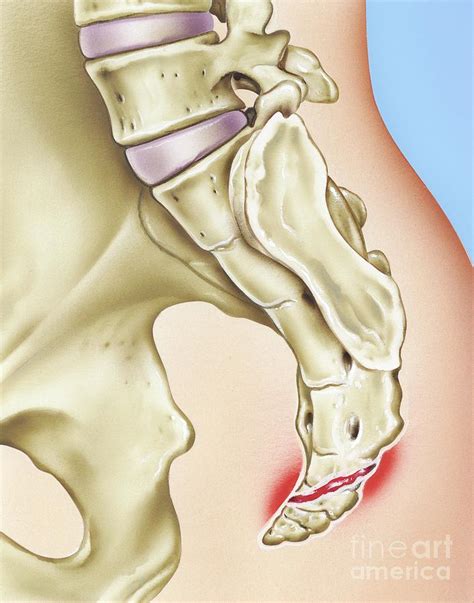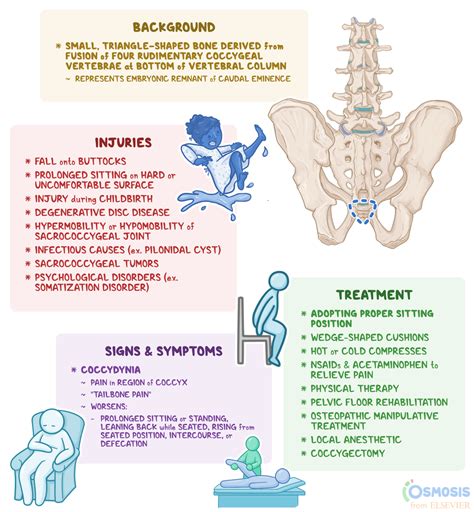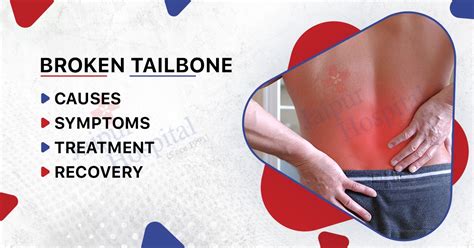Intro
Learn about broken coccyx symptoms, treatment options, and recovery methods for tailbone injuries, including pain management and physical therapy to alleviate coccydynia and related conditions.
The coccyx, also known as the tailbone, is a small bony structure located at the bottom of the spine. It plays a crucial role in supporting the pelvic floor and facilitating sitting. However, the coccyx can be prone to injuries, particularly during falls or direct blows to the area. A broken coccyx, also known as a coccygeal fracture, can be a painful and debilitating condition that affects daily activities. In this article, we will delve into the symptoms and treatment options for a broken coccyx, providing valuable insights for those affected by this condition.
The importance of understanding broken coccyx symptoms and treatment cannot be overstated. A prompt and accurate diagnosis is essential to prevent long-term complications and ensure effective management of the condition. Furthermore, being informed about the available treatment options enables individuals to make informed decisions about their care. Whether you are experiencing persistent pain or discomfort in the tailbone area or are simply interested in learning more about this condition, this article aims to provide a comprehensive overview of broken coccyx symptoms and treatment.
A broken coccyx can result from various causes, including falls onto a hard surface, direct blows to the tailbone, or repetitive strain on the area. The symptoms of a broken coccyx can vary in severity and may include pain or tenderness in the tailbone area, difficulty sitting or standing, and pain during bowel movements or sex. In some cases, a broken coccyx may also cause numbness or tingling in the legs or feet. If you are experiencing any of these symptoms, it is essential to seek medical attention to determine the underlying cause of your discomfort.
Understanding Broken Coccyx Symptoms

Acute Symptoms of a Broken Coccyx
The acute symptoms of a broken coccyx can be intense and debilitating. Some common acute symptoms include: * Severe pain or tenderness in the tailbone area * Swelling or bruising in the affected area * Difficulty sitting or standing * Pain during bowel movements or sex * Numbness or tingling in the legs or feet * Limited mobility or range of motionDiagnosing a Broken Coccyx

Imaging Tests for a Broken Coccyx
Imaging tests play a crucial role in diagnosing a broken coccyx. Some common imaging tests used to diagnose a broken coccyx include: * X-rays: to visualize the bones in the tailbone area * MRI scans: to evaluate the soft tissues, such as muscles, tendons, and ligaments * CT scans: to provide detailed images of the bones and soft tissuesTreatment Options for a Broken Coccyx

Conservative Treatment for a Broken Coccyx
Conservative treatment is often the first line of treatment for a broken coccyx. Some common conservative treatment options include: * Rest and ice: to reduce pain and inflammation * Compression: to reduce swelling and promote healing * Elevation: to reduce swelling and promote healing * Pain relief medications: to manage pain and discomfortPreventing a Broken Coccyx

Risk Factors for a Broken Coccyx
Some individuals may be at a higher risk of developing a broken coccyx due to various factors. Some common risk factors include: * Age: older adults may be more prone to falls and injuries * Obesity: excess weight can increase the risk of falls and injuries * Certain medical conditions: such as osteoporosis or arthritis, can increase the risk of fractures * Participation in high-risk activities: such as contact sports or extreme sportsLiving with a Broken Coccyx

Coping with the Emotional Challenges of a Broken Coccyx
A broken coccyx can have a significant impact on an individual's emotional well-being. Some common emotional challenges include: * Depression: due to chronic pain, limited mobility, or social isolation * Anxiety: due to fear of further injury or uncertainty about the future * Frustration: due to limited mobility or inability to engage in activitiesConclusion and Next Steps

We invite you to share your thoughts, questions, or experiences with a broken coccyx in the comments section below. Your input can help others who may be going through similar challenges. Additionally, if you found this article informative and helpful, please consider sharing it with others who may benefit from this information.
What are the common symptoms of a broken coccyx?
+The common symptoms of a broken coccyx include pain or tenderness in the tailbone area, difficulty sitting or standing, and pain during bowel movements or sex.
How is a broken coccyx diagnosed?
+A broken coccyx is typically diagnosed using a combination of physical examination, medical history, and imaging tests, such as X-rays or MRI scans.
What are the treatment options for a broken coccyx?
+The treatment options for a broken coccyx depend on the severity of the injury and may include pain management, physical therapy, lifestyle modifications, and surgery.
Can a broken coccyx be prevented?
+Yes, a broken coccyx can be prevented by taking certain precautions, such as wearing protective gear, avoiding falls, and maintaining a healthy weight.
What are the potential complications of a broken coccyx?
+The potential complications of a broken coccyx include chronic pain, limited mobility, and bowel or bladder dysfunction.
